In part one of Finding Balance, we looked at the basics of engine balancing,
In this installment, we’ll dive a little deeper into the process of engine balancing and look at some of the shortcomings of traditional balancing techniques. With a firm understanding of these shortcomings, we’ll then take a look at potential solutions in the third and final part of our Finding Balance series.
The Typical Approach
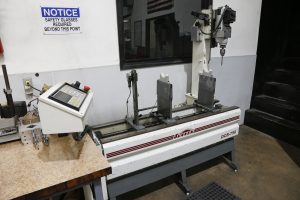
To put the importance of this location in perspective, imagine swinging a rock tied to a string, then doubling the length of string and swinging it again. The rock would pull on your hand twice as hard even though its mass hasn’t changed. The same applies to a crankshaft, because the farther away a given unit of mass is from the crankshaft centerline, the more it will affect the balance of the crank. For example, a crank that’s 20 grams out of balance three inches from the crank centerline is the same as a crank that’s 60 grams out of balance one inch from the crankshaft centerline. This is why the correct unit for measuring crankshaft balance is ounce-inches, not just ounces or grams.
Consequently, the distance any given unit of imbalance is located from the crankshaft centerline is just as important as the amount of imbalance itself. Many engine shops don’t pay any attention to this critical detail, however. In fact, it’s possible for machinists to balance crankshafts for decades without even realizing the importance of specifying the distance of imbalance. The obvious question is, how can this be the case? The answer is simple. The correction radius is the distance from the crankshaft centerline to the edge of the counterweights, and in most domestic V8 engines, that figure is roughly three inches. When a shop orders balancing equipment from Sunnen, the salesman sets up the machine using a three-inch correction radius, and then trains the customer to add or remove material from the crank counterweights until the machine reads ¼ ounce-inch.
The problem with this approach is that once you factor in a three-inch correction radius, the crank is actually ¾ ounce-inch out of balance. So even though a machinist thinks they just balanced a crank to ¼ ounce-inch, it’s actually ¾ ounce-inch out of balance. The reason you can get away with it is because a crank balanced to ¾ ounce inch will run just fine in a typical street/strip motor, and it’s still far better balanced than a production engine.
How Good is Good Enough?
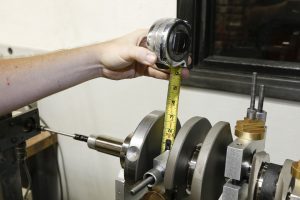
Nevertheless, with NHRA Pro Stock motors approaching 12,000 rpm, and NASCAR Sprint Cup motors turning 9,000-plus rpm for 500-mile races, the ¼ ounce-inch standard becomes less effective in extreme racing engines. The effect of rpm on an engine’s internal loads cannot be underestimated. As engine rpm increases, the tensile loads experienced by the connecting rods — and therefore the crank throws — increase exponentially. In other words, the tensile loads are four times greater at 5,000 rpm than at 2,500 rpm, and 16 times greater at 10,000 rpm than at 2,500 rpm. Likewise, as rpm increases, the effect of ring drag, bearing friction, and cylinder pressure (until peak torque is reached) on an engine’s overall balance, increases as well.
With high rpm and big cubic inches comes serious horsepower, and the cylinder pressure generated along the way impacts engine balance significantly. For example, let’s say conservatively that an NHRA Pro Stock motor produces 3,000 psi of cylinder pressure. When combined with a 4.750-inch bore—which equates to 17.71 square inches of surface area on the piston crown — the result is more than 50,000 pounds of force transmitted to the block and rotating assembly during the power stroke. Clearly, merely balancing a rotating assembly to ¼ ounce-inch isn’t always enough to accurately replicate the dynamic forces inside extreme race engines.
V8 Nuances
The most fundamental factor to consider when balancing a race engine is why a 90-degree V8 needs to be balanced in the first place. This particular configuration presents some inherent challenges. If a V8 was flattened into a horizontally opposed (boxer) configuration, the forces generated by a piston and rod at top dead center (TDC) on one bank of cylinders would be cancelled out by an opposing piston and rod at TDC on the other bank of cylinders. Since each bank of cylinders are phased 180 degrees apart, the forces cancel each other out perfectly and, therefore, do not need counterweights. Much like a flywheel, the primary purpose of the counterweights in these engines is to smooth out the rotational velocity of the crankshaft.
In contrast, when folding the block 90 degrees to create a V8, the pistons and connecting rods generate forces that travel in multiple planes. Since the forces generated by the pistons and rods on opposing banks in a V8 cannot cancel each other out directly, they require counterweights to achieve proper balance. By positioning a counterweight phased 180-degrees away from TDC, they can effectively cancel out the movement of the piston and rod. Further complicating the situation is the fact that pistons and rods positioned at a 90-degree angle to each other transfer forces downward into the cylinder wall as well as at 45-degree angle to the crankshaft. The 50-percent reciprocating weight factor used during the balancing process attempts to compensate for these forces that are generated in multiple planes.
Center Counterweights
The textbook explanation for how counterweights offset rotating and reciprocating mass is easy enough to understand, but it’s only a partial explanation of the actual dynamic forces at hand. That’s because most 90-degree V8 crankshafts have only six counterweights, which means the two center cylinders don’t have counterweights beneath them. Having two sets of pistons and rods whose bobweights are unaccounted for requires adding this mass to the six existing counterweights. Although this approach works fine from a math standpoint, the counterweights aren’t in the ideal position to cancel out the forces of the two center cylinders. Not surprisingly, this leads to extremely uneven bearing loads where the forces on the #2 and #4 main caps can be significantly higher than on the #1, #3, and #5 main caps.
Additionally, as horsepower and rpm increase, the rotational inertia of the counterweights combined with their positioning at the far ends of the crankshaft impart their own torsional loads into the crankshaft. This effect is similar to the torsional loads channeled into the crank by the flywheel and balancer in an externally balanced engine. Ultimately, these loads can lead to crank fatigue and crank failure.
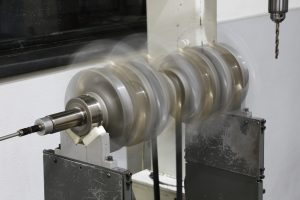
The Factors Unaccounted For
Among the dozens of variables that traditional balancing methods don’t account for, peak engine rpm and horsepower output are two of the most significant factors. However, putting the extremely complex science of balancing into perspective requires examining variables such as ring drag, rod length, counterweight phasing, stroke length, bearing friction, secondary vibrations, rocking couples, and static mass in closer detail. Individually, each of these variables may not dramatically affect overall engine balance, but cumulatively their effects are quite significant.
Weight and Power
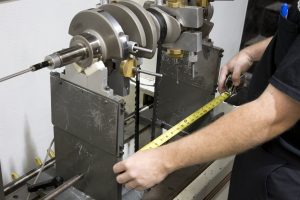
Internal Friction
Ring drag and bearing friction are easy concepts to understand. During the balancing process, the crankshaft sits on two precision-calibrated stands which support the front and rear mains journals. The crank rides on plastic inserts fitted to the top of the stands, and oil is squirted onto the crank to reduce friction and protect the mains. As such, the balancer sees just a miniscule fraction of the bearing friction a crank will encounter in a running engine. Likewise, the pistons aren’t actually attached to the crank during balancing, so ring drag is a non-factor.
On the other hand, when turning an assembled short block over by hand, it takes about 30 ft.-lbs. of torque to rotate the crank in a typical street/strip engine equipped with standard tension rings. Most of that required force is attributable to ring drag and bearing friction. Increase engine speed to 7,000 rpm, and the horsepower required to overcome that 30 foot-pounds of drag is substantial. That resistance is channeled back through the crankshaft and block as unbalanced force.
Secondary Vibrations
Rotating and reciprocating forces generated once per crankshaft revolution are defined as primary forces. Rotating and reciprocating forces generated twice per crankshaft revolution are defined as secondary forces. While primary forces are easy to visualize, understanding secondary forces is less intuitive. Imagine drawing a line on the cylinder wall precisely halfway between TDC and BDC (bottom dead center). Since the wristpin is positioned slightly below the piston crown, when the crank pin rotates downward to half the length of the stroke, the piston actually travels a distance greater than half the length of the stroke. As a result, the piston accelerates away from TDC toward the halfway point more quickly than it accelerates from the halfway point toward BDC. The same applies as the piston reverses direction back up the bore. In other words, the piston’s rate of acceleration increases once it passes the halfway point on its way back up toward TDC. This disparity in piston acceleration creates an upward vibration which occurs twice per crankshaft revolution. That’s where the term secondary force (or vibration) comes from.
Fortunately, since each of the four crankpins in a cross-plane V8 are phased 90 degrees apart, there are always pairs of pistons moving through different phases of the crankshaft rotation cycle. As the first crank pin (from the front) rotates down from TDC to 90 degrees after TDC, the third crank pin travels from 90 degrees before TDC to TDC. Likewise, as the second crank pin rotates down from 90 degrees after TDC to BDC, the fourth crank pin travels up from BDC to 90 degrees before TDC. Consequently, the fast downward movement of the first crank pin cancels out the fast upward movement of the third crank pin, and the slow downward movement of the second crank pin cancels out the slow upward movement of the fourth crank pin. This effectively cancels out the secondary forces.
Unlike many of the other variables discussed thus far, secondary forces aren’t ignored by traditional balancing methods. They simply don’t seem as important in a crossplane V8 since this particular engine configuration naturally cancels out secondary forces.
Rocking Couple
One downside of the crossplane V8 configuration is that the design of the crankshaft creates a see-saw rocking motion from front to back. This is because the first and second crank pins move upward at the same time, while the third and fourth crank pins move downward at the same time. Since the orientation of the front two crank pins and rear two crank pins reverse every 180 degrees of rotation, the crank rocks up and down like a see-saw. This rocking couple is yet another force that the counterweights are responsible for cancelling out.
Similarly, each pair of rods share a common crank pin in a 90-degree V8, which requires staggering their positioning to prevent them from running into each other. This offset creates another rocking vibration that’s difficult to eliminate. These rocking couples can be eliminated through some clever engineering, but they aren’t addressed directly, as cancelling them out usually requires completely redesigning the short-block components.
For example, V-twin engines often utilize a blade-and-fork rod arrangement. In this type of setup, one rod is forked while the adjacent rod fits in between the “prongs” of the neighboring rod’s fork. This allows both rods to share a common crank pin and to also be positioned on the same vertical plane, thus eliminating the rocking vibration. Domestic V8 manufacturers would have probably experimented with a similar design if it was worth the effort, which suggests that this particular rocking couple is only a minor issue. Even so, it’s still one of dozens of variables that can impact balancing in some way or form that isn’t directly addressed.
Cylinder Pressure
Granted that the cylinder pressure pushing down on the rotating assembly is immense during the power stroke, but that’s not the only cycle during the four-stroke process that affects engine balance. As an engine cycles through the intake, compression, power and exhaust strokes, the cylinder pressure is constantly changing. Changes in throttle position and engine rpm create even larger swings in cylinder pressure.
To illustrate the point, imagine a scenario where a driver winds an engine to 9,000 rpm at wide-open throttle, then suddenly snaps the throttle shut while stepping on the clutch. Not only has the rpm suddenly dropped, but the engine has transitioned from having tens of thousands of psi of positive cylinder pressure during the power stroke to having negative cylinder pressure on the intake stroke. The resulting shock would send quite a bit of unbalanced force through the motor. Although this is an extreme and contrived example, pushing an engine through far lesser extremes still subjects it to large changes in cylinder pressure that adversely affect balancing.
Rod and Stroke Length
Rod-to-stroke ratio has long been debated regarding its impact on horsepower and torque. What isn’t as controversial is its impact on balancing. As the length of the stroke increases, the rod angularity increases. The same applies to when the stroke length remains the same, but rod length is reduced. Any increase in rod angularity increases the side loads transmitted into the cylinder walls, thus increasing the unbalanced forces inside an engine. In other words, the lower the rod-to-stroke ratio, the greater the magnitude of unbalanced force will be on the engine. Consequently, a 400 small-block Chevy with 5.565-inch rods and a 3.750-inch stroke (1.48:1 ratio) will generate greater imbalance than a 302 small-block Chevy with 5.700-inch rods and a 3.000-inch stroke (1.90:1 ratio), since the 400’s rods oscillate in a larger arc.
Measuring Rod Weight
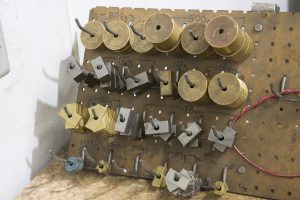
Breaking things down further, the section of the rod beam directly beneath the wrist pin oscillates in a very small arc, which means that its reciprocating motion is far greater than its rotating motion. In contrast, the big end of the rod oscillates in a very large arc, which means that its rotation motion is far greater than its reciprocating motion. Therefore, the upper sections of the rod beam (closer to the wrist pin) reciprocate more than rotate, while the lower sections of the rod beam (closer to the crank pin) rotate more than reciprocate. At the half-way point between the big and small rod ends, 50 percent of the rod movement reciprocates, and 50 percent of the rod movement rotates.
Interestingly, the conventional method of measuring the weight of a connecting rod takes none of this into account. Measuring the weight of the big and small ends of the connecting rod independently involves placing it in a simple fixture which supports each end on a stand. One stand rests on the scale, while the other rests on the table. To weigh the big end of the rod, it’s placed on the stand resting on the scale. The small end of the rod is raised or lowered on its adjustable stand (resting on the table) until the rod is horizontal. To weigh the small end of the rod, the entire procedure is repeated after reversing the orientation of the rod 180 degrees.
The fundamental flaw with this method is that it assumes the center of gravity is the half-way point on the rod where 50 percent of rod movement is reciprocating, and 50 percent of rod movement is rotating. If this was true, the half-way point would be heavily biased toward the big end of the rod, since in reality the big end is much heavier. To illustrate the point, imagine attaching heavy magnets to the big end of the rod. According to the conventional method of weighing a rod, the resulting shift in center of gravity would also change the reciprocating weight dramatically, when clearly this isn’t the case. Similarly, since the center of gravity of a rod is much closer to the big end of the rod than the small end of the rod, it assumes that the majority of the rod beam represents rotating mass. However, even sections of the rod beam very close to the wristpin oscillate in a rotating motion, so this assumption is also inaccurate.
Over/Under Balance
Considering the inherent problems associated with weighing a rod off of its center of gravity, suspending it by a string at its geometric center, then weighing the big and small ends, yields far more precise results. Using this method, the measured reciprocating weight of the rod would decrease, while its measured rotating weight would increase. The net effect is a three percent increase in bobweight.
Interestingly, this increase in bobweight seems to support the practice of overbalancing a crankshaft. Many engine builders claim that adding an extra one to five percent of mass to the reciprocating weight helps even out bearing wear. For example, setting up the bobweights to 100 percent of the rotating weight and 53 percent of the reciprocating weight is the equivalent of overbalancing a crankshaft by three percent. Let’s say that an LS1 rotating assembly calls for a bobweight of 1800 grams. In this example, the rotating weight is 880 grams and the reciprocating weight is 920 grams. Adding three percent to the reciprocating weight equals 947.6 grams, which represents an overall increase in bobweight of 27.6 grams, or 1.5 percent.
Nevertheless, it would be overly presumptuous to declare the validity of overbalance based on this simple example. While overbalancing is common in race engines, some engine builders have found no benefits to overbalancing. Meanwhile, others claim that underbalancing a crank to less than 50 percent of the reciprocating weight improves bearing wear. The only thing that is certain is that there is no consensus among engine builders regarding the benefits of over- or underbalancing a crankshaft. Ultimately, the traditional method of measuring the weight of a connecting rod based on its center of gravity is far from precise, but it tends to work well enough in most engine applications.
In Part Three, we’ll take a look at potential solutions for the shortcomings we listed.

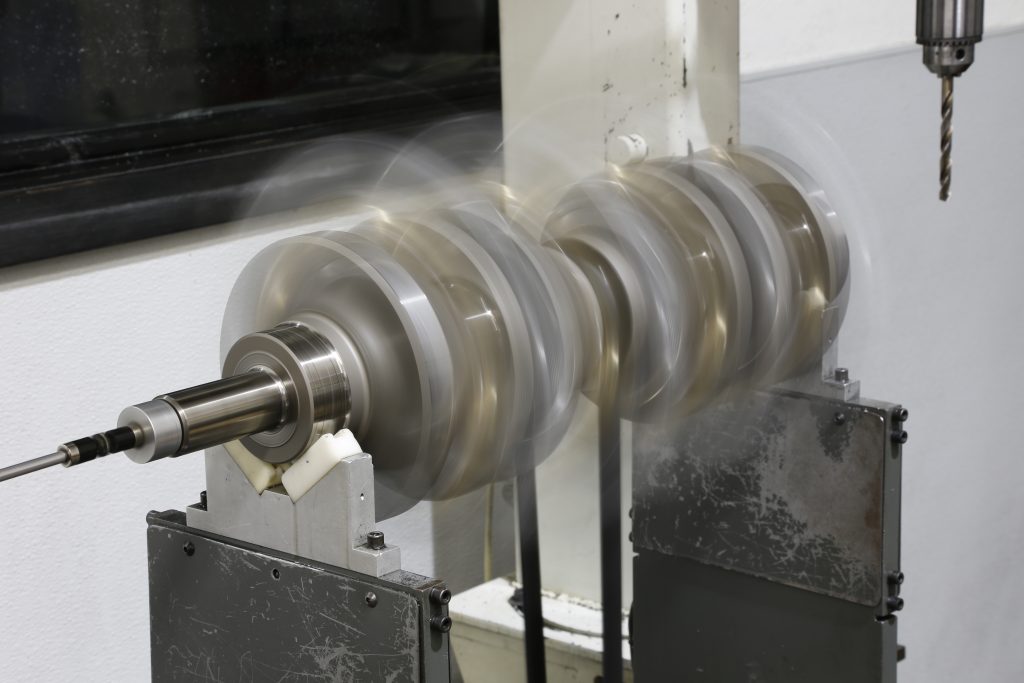
[…] Part 2 […]
Finding the imbalance specs is just a start in the process. Where is the precise location, ie ends, middle or somewhere between. I do not ever have concerns with a stock unit. With HP cranks the tech book opens and the process begins.
[…] Part 2 of Finding Balance, we covered some of the variables that go accounted for during most traditional engine balancing […]
In the paragraph about secondary vibrations, I understand it to say that the piston travels at it’s fastest rate at 90′ after TDC. Not trying to split any hairs here, but wouldn’t the piston’s fastest rate of travel be when the crank throw and the connection rod are at a perfect 90′ to each other? This rotational position would be different on each engine depending on the connecting rod length, the deck height of the block and the stroke of the crank. This position of perpendicularity of the rod and crank throw would happen before the piston reaches the halfway point of the stroke. Likewise on the rise of the piston, it would happen shortly after the piston has passed the halfway point of the upward stroke.
[…] Finding Balance (Part 2): Examining the Shortcomings of Typical Engine Balancing Techniques […]
hello JUD! Good job. hope you and the fanily are doing O.K. Dema
[…] In Part 2 of this series on engine balancing, we will take a closer look at the shortcomings of traditional balancing techniques. […]
Very interesting article. I realize its been a few years .
But what is meant by ”geometric center” of the rod? Is it the mid point from end to end? Or would it be some centroid that takes the whole shape in consideration?
Also suspending it by a string one would only be able to weigh the big end since its heavier. So I assume its a typo that one would measure both sides this way.
Another suggested method Ive read was finding the balance point and use the percentage of the distance to calculate end weights as that percentage of the whole weight.
When comparing these methods on a standard chevy small block rod (5.7”) you get big end weights that are within 30gr of each other.
The percentage being between 58 and 68% .
Maybe those are all within the right margin?
When working on racing Moto Guzzi V twins for endurance racing, we took the C of G as the nominal mid point of the rod (even though it wasn’t) and balanced the crankshaft to 100% of one rod and piston, plus the larger weight of the second rod from the center of the rod to the big-end, plus the extra calculated weight of the steel material from the actual rod center to the actual C/G. This resulted in a balance factor greater than standard and required extra material being welded to the bob weight. This was found to have less vibration over a larger rev range than standard. Would you consider this to be the ideal counterweight system?